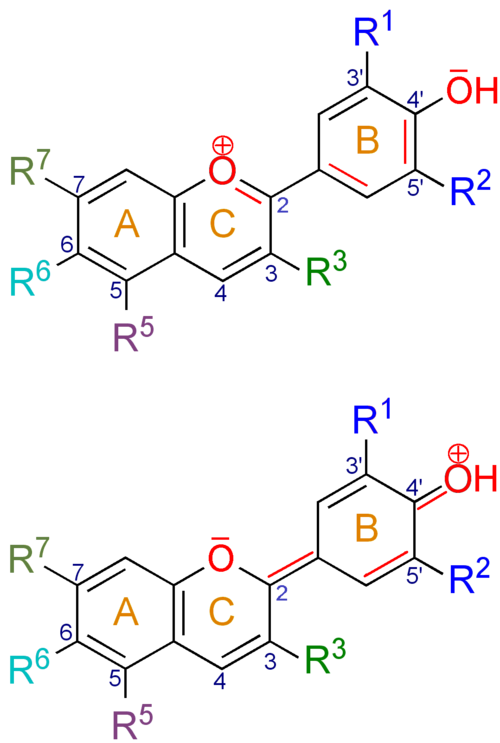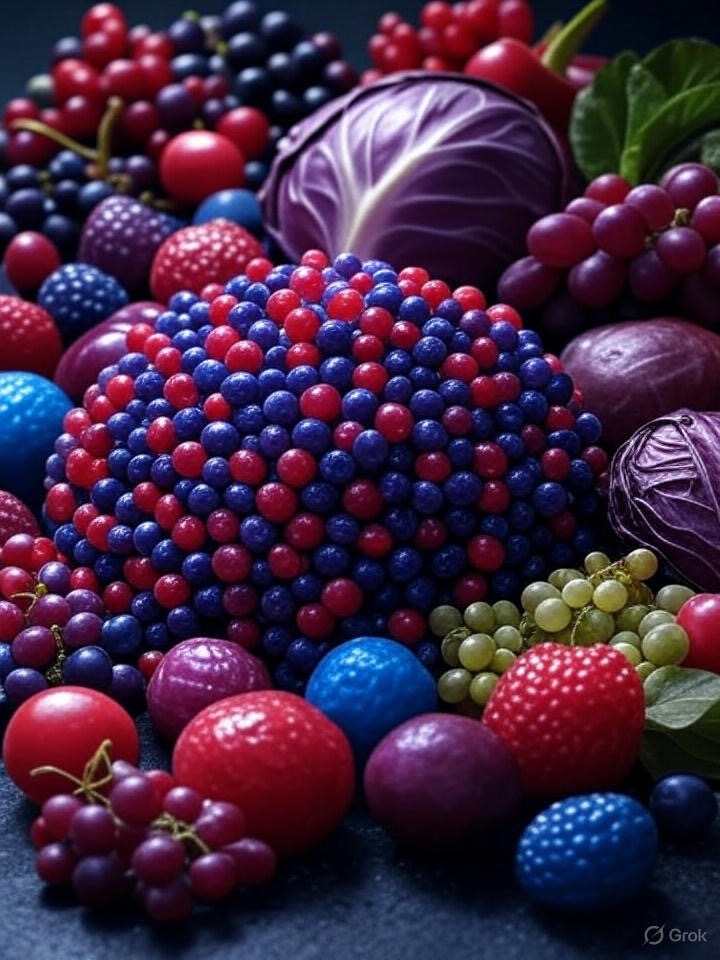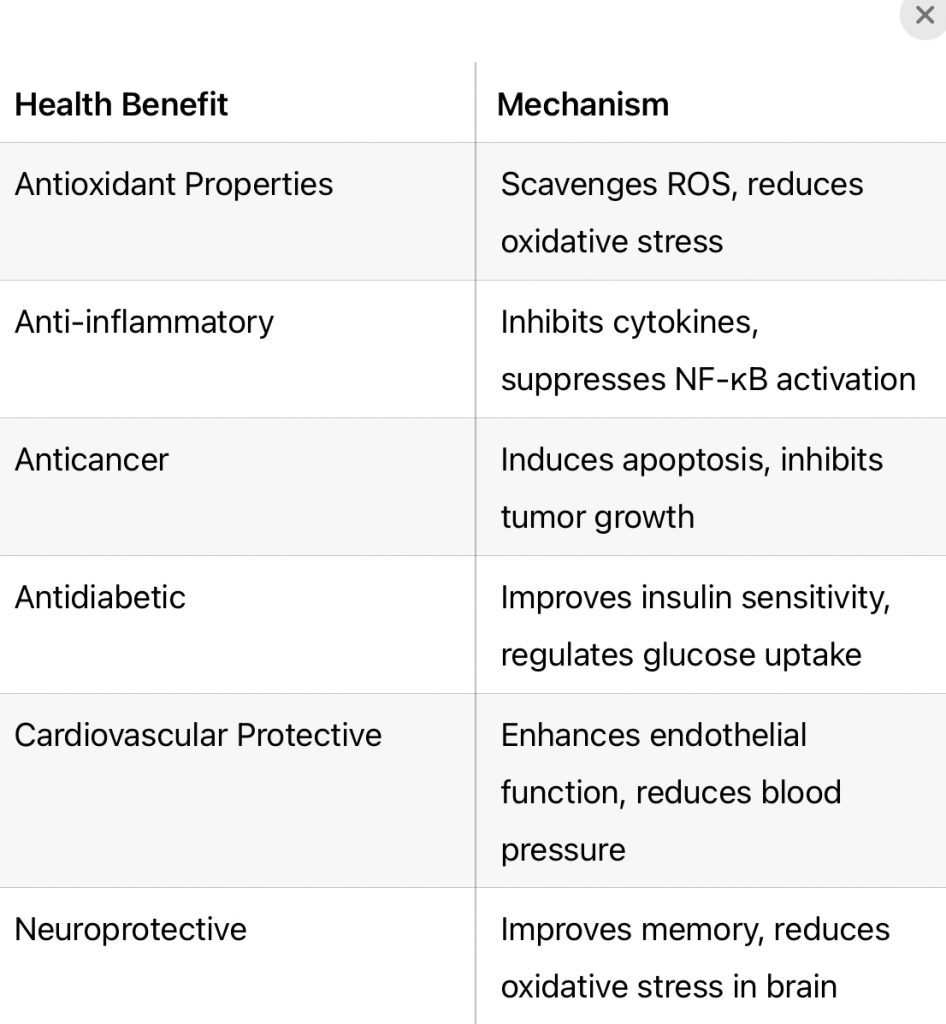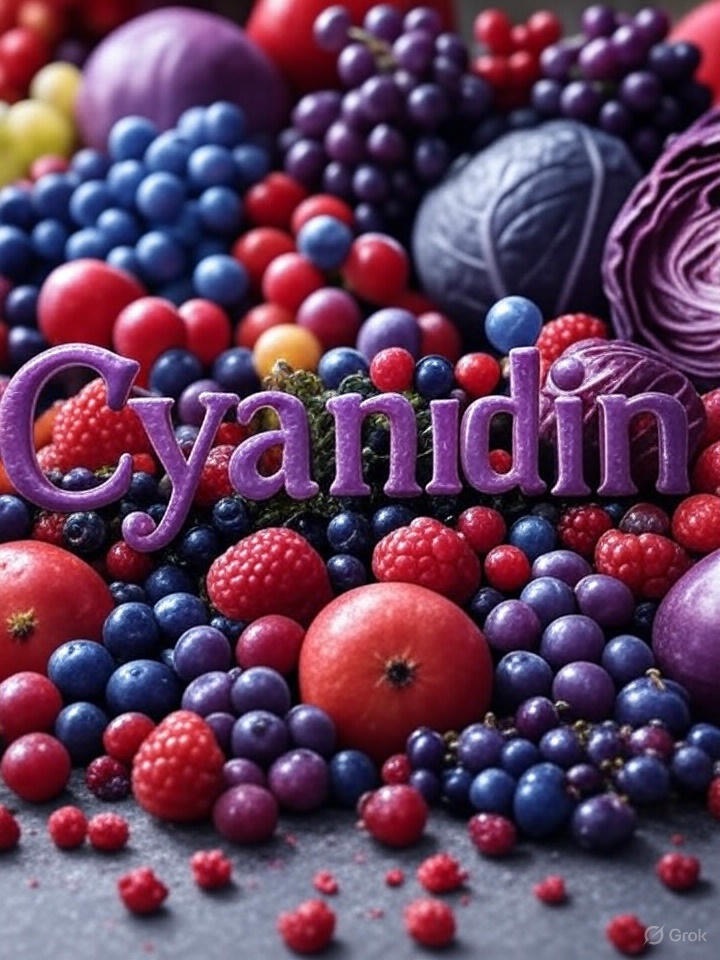( purple, blue and red pigment)
Key Points
- Research suggests cyanidin may offer antioxidant and anti-inflammatory benefits, potentially supporting heart and brain health.
- The evidence leans toward cyanidin helping with diabetes management and possibly reducing cancer risk, though more human studies are needed.
- It seems likely that cyanidin supports eye health and protects against toxin-induced damage, but results vary by study.
What is Cyanidin?
Cyanidin is a natural pigment found in red, purple, and blue fruits and vegetables like berries, grapes, and red cabbage. It’s part of a group called anthocyanidins, known for their vibrant colors and potential health benefits.
Potential Health Benefits
Studies show cyanidin might reduce oxidative stress and inflammation, which could lower the risk of heart disease and improve brain function. It may also help manage blood sugar for diabetes and protect against certain cancers, though these effects are more established in lab and animal studies than in humans. Some research suggests it supports vision and protects organs from toxins, but the evidence isn’t conclusive yet.
Sources and Safety
You can get cyanidin from eating berries, red grapes, and red onions. It’s generally safe in food, but high-dose supplements might cause stomach issues, and interactions with medications are possible, so consult a doctor if considering supplements.

Anthocyanin-containing foods
Red, purple, and blue fruits and vegetables typically boast the highest amount of anthocyanins. The following foods contain the most anthocyanins per 3.5 ounces (100 grams) (5 Trusted Source):
Mulberries: 1.4–704 mg
Black chokeberries: 46–558 mg
Black elderberries: 17–463 mg
Black currants: 25–305 mg
Sweet cherries: 7–143 mg
Blackberries: 10–139 mg
Lingonberries: 4–49 mg
Strawberries: 4–48 mg
Sour cherries: 3–44 mg
Red raspberries: 5–38 mg
Black grapes: 3–39 mg
Plums: 5–34 mg
Blueberries: 11–26 mg
Black beans: 1–15 mg
Red currants: 2–11 mg
Red wine: 4–10 mg
Red onions: 7 mg
Other anthocyanin-rich foods include purple corn, pomegranate, eggplant, black carrots, red cabbage, and purple cauliflower, which may provide anywhere from a few to 200–300 mg per 3.5 ounces (100 grams) (6 Trusted Source).
The anthocyanin content of these foods varies so widely because growing area, climate, season, light exposure, harvest time, and storing temperature all affect antioxidant content (6 Trusted Source).
Amounts may also depend on whether foods are fresh, frozen, or dried — the last of which typically has the lowest anthocyanin content (7 Trusted Source).
To maximize your intake of anthocyanins from these foods, eat them raw and at their ripest if possible.
Survey Note: Comprehensive Analysis of Cyanidin’s Health Implications
Cyanidin, a natural anthocyanidin and flavonoid pigment, is found in various red, purple, and blue fruits and vegetables, such as berries (blueberries, blackberries, raspberries), red grapes, plums, red cabbage, and red onions. Its vibrant colors are not just aesthetic; they signal potential health benefits due to its antioxidant, anti-inflammatory, and other bioactive properties. This survey note explores cyanidin’s health implications in depth, drawing from recent research and studies to provide a comprehensive overview for health-conscious individuals and researchers.
Chemical and Biological Properties
Cyanidin is a polyphenolic compound, specifically an anthocyanidin, with a chemical structure that allows it to act as a potent antioxidant. It exists in plants as glycosides, such as cyanidin-3-glucoside (C3G) and cyanidin-3-O-galactoside (Cy3Gal), which are commonly found in foods. Its ability to donate electrons or neutralize free radicals underpins many of its health effects. After consumption, cyanidin glycosides are partially absorbed in the stomach and small intestine, with much metabolized by gut bacteria into smaller compounds like protocatechuic acid. Bioavailability is relatively low, estimated at around 2%, but its metabolites may still contribute to health benefits, as detected in human blood serum and rat tissues post-consumption (Cyanidin – an overview | ScienceDirect Topics).

Health Benefits: Detailed Analysis
Antioxidant Properties
Cyanidin, particularly Cy3Gal and C3G, exhibits strong antioxidant activity by scavenging reactive oxygen species (ROS) and reactive nitrogen species, reducing oxidative stress linked to aging, inflammation, and chronic diseases. A 2016 study by Bellocco et al. identified Cy3Gal in pistachio hulls and demonstrated its superior antioxidant capabilities in DPPH, ABTS, and oxygen radical absorbance capacity (ORAC) tests, showing higher ferric ion reducing power compared to other anthocyanins like Pg3Glu and Mv3Glu (Cyanidin 3-O-galactoside: A Natural Compound with Multiple Health Benefits – PMC). It also protects against lipid peroxidation and reduces oxidative damage in cells, as seen in studies on human dermal fibroblasts and lymphocytes, with mild inhibitory effects on ROS production in activated neutrophils.
Anti-inflammatory Effects
Cyanidin’s anti-inflammatory properties are well-documented, particularly through its ability to inhibit proinflammatory cytokines like TNF-α, IL-6, and IL-8, and suppress NF-κB activation. Extracts containing Cy3Gal, such as from chokeberries, have been shown to reduce inflammation in LPS-activated human monocytes and mouse macrophages, suggesting potential benefits in managing chronic conditions like arthritis and inflammatory bowel disease (Cyanidin 3-O-galactoside: A Natural Compound with Multiple Health Benefits – PMC). Saskatoon berry and dark blue grained wheat extracts, rich in cyanidin, also impede peroxyl radical-induced oxidation in immune cells, further supporting its anti-inflammatory role.
Anticancer Potential
Research suggests cyanidin may have anticancer effects, particularly in lab and animal models. Chokeberry extracts rich in Cy3Gal inhibit the growth of colon cancer cells (HT-29) and induce apoptosis, with minimal effects on normal cells (NCM460), while crabapple extracts high in Cy3Gal inhibit gastric cancer cell growth and promote apoptosis via Bax and Bak upregulation (Cyanidin 3-O-galactoside: A Natural Compound with Multiple Health Benefits – PMC). A 2019 review in Molecules highlighted cyanidin’s potential to suppress tumor progression by inducing apoptosis and inhibiting angiogenesis, though human trials are limited, indicating a need for further research (Cyanidin – an overview | ScienceDirect Topics).
Antidiabetic Effects
Cyanidin, especially Cy3Gal, shows promise in diabetes management. Studies on diabetic rats treated with chokeberry extracts demonstrated reduced serum glucose levels and improved lipid profiles, with chokeberry juice lowering plasma glucose and triglycerides in streptozotocin-induced diabetic rats (Cyanidin 3-O-galactoside: A Natural Compound with Multiple Health Benefits – PMC). A 2020 human trial in Nutrients found that anthocyanin-rich berry extracts (including cyanidin) improved insulin resistance in type 2 diabetes patients, attributed to enhanced insulin sensitivity and glucose uptake regulation (Potential Benefits of Cyanidin 3-Glucoside (C3G) + Dosage – SelfDecode Supplements).
Cardiovascular Protection
Cyanidin contributes to cardiovascular health by improving endothelial function, reducing platelet aggregation, and lowering blood pressure. Chokeberry juice, rich in Cy3Gal, induces endothelium-dependent relaxations in coronary arteries and decreases thrombin-induced fibrinogen polymerization, with antiplatelet properties reducing platelet adhesion to collagen (Cyanidin 3-O-galactoside: A Natural Compound with Multiple Health Benefits – PMC). A 2016 study in the Journal of Nutrition linked anthocyanin intake (including cyanidin) to a reduced risk of coronary artery disease, suggesting benefits in preventing heart disease, stroke, and hypertension (Anthocyanin: Foods, Benefits, Side Effects, and Supplements).
Neuroprotection
Cyanidin, particularly Cy3Gal, has neuroprotective effects, improving learning and memory in aged mice, as evidenced by performance in the Morris water maze and passive avoidance tests. It increases antioxidant enzyme levels (SOD) and decreases oxidative stress markers (MDA) in the brain, reversing scopolamine-induced memory impairment and protecting against ischemia-induced brain damage (Cyanidin 3-O-galactoside: A Natural Compound with Multiple Health Benefits – PMC). A 2021 study in Frontiers in Nutrition linked anthocyanin-rich diets (including cyanidin) to slower cognitive decline in older adults, suggesting potential applications in treating neurodegenerative diseases like Alzheimer’s.
Eye Health
Cyanidin may support eye health by protecting retinal cells from oxidative damage and improving blood flow to the eyes. Studies on anthocyanins (including cyanidin) from bilberries and blackcurrants have shown improved night vision and reduced eye fatigue in small human trials, attributed to enhanced rhodopsin regeneration and protection against oxidative stress (Cyanidin 3-Glucoside Capsules | 125mg | Black Rice Extract | Oryza sativa | Metabolic, Vision, & Cognitive Support).
Anti-toxicity
Cyanidin demonstrates protective effects against toxin-induced damage. Chokeberry juice containing Cy3Gal reduces indomethacin-induced gastric mucosal damage by mitigating oxidative stress, while chokeberry extracts suppress potassium bromate-induced renal and hepatic damage, highlighting its role in detoxifying and protecting vital organs (Cyanidin 3-O-galactoside: A Natural Compound with Multiple Health Benefits – PMC).
Sources, Intake, and Bioavailability
Cyanidin is abundantly found in red, purple, and blue fruits and vegetables, with a list of 26 cyanidin-rich foods ranked by content available at 26 Cyanidin Rich Foods (Ranked) | Hydration Monitoring – Intake Health Blog. Key sources include blueberries, blackberries, raspberries, red grapes, plums, red cabbage, and red onions, with chokeberries noted as a practical source for Cy3Gal extraction. No official dietary recommendation exists for cyanidin alone, but anthocyanin intake of 10–100 mg/day (from 1–2 servings of berries) is linked to benefits. Bioavailability is low, around 2%, with detectable levels in human blood serum post-blueberry ingestion, suggesting that even small amounts can exert biological effects (Cyanidin 3-O-galactoside: A Natural Compound with Multiple Health Benefits – PMC).
Safety and Potential Risks
Cyanidin is generally safe when consumed through food sources, with a 2024 study on rats finding no adverse effects at doses up to 30 mg/kg/day, establishing a no-observed-adverse-effect level (NOAEL) at this dose (Assessment of oral toxicity and safety profile of cyanidin: acute and subacute studies on anthocyanin – PMC). However, high-dose supplements may cause mild gastrointestinal issues like diarrhea or bloating, and potential interactions with cytochrome P450 enzymes could affect drug metabolism, warranting caution for supplement users.
Research Gaps and Future Directions
While lab and animal studies provide strong evidence for cyanidin’s benefits, human trials are often small, short-term, or focused on whole foods rather than isolated cyanidin. Long-term effects, optimal doses, and the role of gut microbiota in metabolism remain unclear, necessitating larger, longitudinal studies. Future applications may include functional foods, nutraceuticals, or targeted therapies, particularly for chronic diseases.
Practical Implications
For daily health, incorporate cyanidin-rich foods like berries and red cabbage into your diet, preferably fresh or lightly cooked to retain anthocyanins. Combine with a balanced diet and exercise for maximum benefits. Consult a healthcare provider before using supplements, especially if on medications or managing chronic conditions.
Summary Table: Key Health Benefits of Cyanidin

| Eye Health | Protects retinal cells, improves blood flow |
| Anti-toxicity | Reduces toxin-induced damage, mitigates oxidative stress |
Key Citations
- Cyanidin 3-O-galactoside: A Natural Compound with Multiple Health Benefits – PMC
- Cyanidin – an overview | ScienceDirect Topics
- Potential Benefits of Cyanidin 3-Glucoside (C3G) + Dosage – SelfDecode Supplements
- 26 Cyanidin Rich Foods (Ranked) | Hydration Monitoring – Intake Health Blog
- Anthocyanin: Foods, Benefits, Side Effects, and Supplements
- Cyanidin 3-Glucoside Capsules | 125mg | Black Rice Extract | Oryza sativa | Metabolic, Vision, & Cognitive Support
- Cyanidin-3-glucoside as a possible biomarker of anthocyanin-rich berry intake in body fluids of healthy humans: a systematic review of clinical trials – Nutrition Reviews
- Assessment of oral toxicity and safety profile of cyanidin: acute and subacute studies on anthocyanin – PMC
